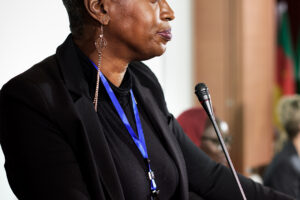A Study in Evil: The Slave Trade in Africa.
Abstract: In this special issue on justice, ethics, and philosophy of religion, let us consider a historical case study. The trade of slaves across the Atlantic lasted 400 years and led to the forcible removal of about 12.5 million people from Africa, south of the Sahara. This paper examines the African slave trade in light of the notion that evil of whatever form is a menace to our very existence and a rupture of the very essence of hope. It will focus on the nature, development, and growth of the African/European Slave Trade, as it interrogates issues such as: if evil is coterminous with human cruelty, then the slave trade was the apogee of human evil and avarice; the notion of slavers saving the enslaved from themselves; and providing an avenue for conversion into Abrahamic religions. The essay will also be interested in how slavers—European and Africans alike—rationalized slavery and how the enslaved and onlookers responded to the spectacle of enslavement.
Keywords: slavery; slave trade; Atlantic; Muslim; Africa; domestic; Islam; servitude; evil; greed;
enslavement; property
- A Study in Evil: The Slave Trade in Africa.
Sometimes, the current debate on the origins of and compensation for slavery is less than well grounded, historically. This is an historical essay, designed as a prolegomena, setting up the context for further philosophical inquiry. In The Interesting Narratives (Equiano 1995), Equiano (1745–1797), born in what is now eastern Nigeria and kidnapped into slavery at age 11, aptly summed up what many consider today as one of the greatest crimes against humanity. Upon experiencing cruel brutality during the Middle Passage, Equiano declared that he “now wished for the last friend, death” to come and take him away and that he “will not recommend this treatment even for [his] enemies” (Equiano 1995). On another level, upon observing the suffering of slaves, Paul E. Isert (d. 1789), a German-born surgeon working for the Danish Guinea Company at Christiansborg in 1786, in present-day Ghana, concluded that, for two centuries, “the Black Slave Trade” constituted “the shame of mankind” (Isert [1788] 1992, pp. 147–59) and the apogee of human avarice. What was the overriding notion about the human condition that drew people to rationalize, often with religious reasons, and engage in the sale of other human beings? Is there such a thing as “just enslavement” to which other people, the so-called descendants of Ham (Genesis ix, pp. 20–27; Sanders 1979, pp. 521–32; and Bashir 2019, pp. 92–116) and those suffering th Qur’anic injunction of “unbelief” (Hunwick 2000; Sanneh 1976) were condemned? How do we account for the harsh realities, and can we define all forms of servitude as “social death” that denies its victims the right to participate in society? The institution of slavery has had a place in settled societies and has been practiced in various forms since antiquity. Slavery is traced as far back as the early civilizations of Mesopotamia, Egypt, classical Greece, and Rome and into the Slavic countries. In Roman law, for instance, slavery was defined as a relationship issue—between a person and a thing, where the “thing,” the slave, was often categorized as an intruder and not really part of society (Cruz-Uribe 1986, p. 309). From the Republic to the Empire, Rome procured slaves or replenished their slave stock from two sources: (1) prisoners of war, or outright purchase from their borders in exchange for silver and wine from the Mediterranean world, or (2) they relied on the familia, as defined by Roman law, which stipulated that infants born of slave parents were slaves by law. Just as in most other settled societies, people came slaves and were defined as such when procured through war, sold, bought, and used for a variety of purposes ranging from the cultivation of the land to administration, the military, and domestic services. From the activities of the North African Arab trading networks and raiding, Africans made their way into the Mediterranean world and into the Indian Ocean Basin as slaves. This is not a suggestion that Africans did not have their version of what will later be described as slavery, which will be discussed shortly. In western societies, the term slavery is often defined as “the legal institutionalization of persons as property” with set rights over the property that included freedoms, the use of its productive and reproductive capacities, and, sometimes, the power over life and death (Miers and Kopytoff 1977, p. 11). It also carried connotations of “ownership property, and the purchasing of people” (Miers and Kopytoff 1977, p. 11). So defined and practiced in western societies, the term slavery invites lots of “misleading ambiguities” and misinterpretations, especially when applied to Africa and other non-western societies. Suzanne Miers argued in the 1970s that, in Africa, what Europeans misunderstood to mean slavery was African kingship, a concept that sometimes privileged the exercise of control over wives, children, and other family members and required, in some cases, a form of transaction akin to the purchase and disposal of property in western societies. Though Miers’ definition focused on domestic slaves and was unable to capture slaves on plantations and in mines (Klein and Lovejoy 1979, pp. 181 212), nonetheless, it is still accurate to assert that the term slavery was used to refer to a situation far removed from European comprehension. It is thus appropriate, as Bloch cautioned, that the essence in any discussion of slavery must take into account the “two conceptual balancing acts” of (a) an understanding of the system of exploitation of which the system (slavery) forms a part and (b) the evolution of the terminology (Lane and MacDonald 2011). Certainly, the use of the term “slave” is of foreign origin and has come to mean “Persons who are held in captivity, and who may be bought or sold” (Lovejoy 1983, p. 110). The purpose of all forms of bondage not only defines slavery but was also transformed with European and Arab contact. Contact with Arab and European slavers changed the dynamics of slavery and the slave trade in Africa. It is thus without doubt that the western conception of slavery, and
the uses to which slaves were subjected, had different connotations in different parts of the world, and its introduction and evolution in Africa transformed the regime of bondage and servitude (for further discussion, see Lovejoy et al. 1979).
Africans experienced three distinct types of slave trades: (1) The European Slave Trade that took Africans across the Atlantic from the mid-fifteenth century until the end of the nineteenth century; (2) the Arab Slave Trade across the Sahara and the Indian Ocean that predated European contact with Africa; and (3) domestic slavery. The three exhibited the distinguishing features of procurement, the capacity for assimilation, treatment, and the purposes for which they acquired slaves, all of which in turn determined the level of cruelty for slaves. Yet, in a 2010 response to Henry Louis Gates on the “African Involvement in the Slave Trade”, Molefi Kete Asante of Temple University argued forcibly that there was no such thing as an African Slave Trade but insisted on two types of slave trades: the European slave trade across the Ocean and the Arab Slave Trade across the desert (Asante 2014). This falls in line with the discourse on slavery in Africa, which tends to focus less on the origins and nature of slavery but rather on two strands of arguments—(1) whether slavery emerged in response to European and Arab demands for slaves or (2) whether Europeans and Arabs simply tapped into an already existing practice in Africa (Fage 1969, pp. 393–404).
This discourse on the Slave Trade crystalized into two schools of thought led by Walter Rodney and J. D. Fage.1 While Walter Rodney argued that slavery in Africa emerged in response to European demand, J. D. Fage held the opposing view that slavery is indigenous to Africa and was already widespread and endemic prior to European contact. For Fage, Europeans simply tapped into an already existing system of slavery (Fage 1969, p. 393). In 1980, J. D. Fage continued the discussion by examining published European eyewitness
accounts from Angola to Senegal and argued that, during the first contacts in the fifteenth century, Africans offered European traders what was termed as ‘slaves’ as articles of trade (Fage 1980, p. 310). While there was no such thing as a “slave class” in West Africa, the existence of monarchical governments in Africa whose status rested on dependents, recruited by force or by judicial and economic means, made it possible for masters to exchange such defendants for other forms of wealth. For J. D. Fage, in essence, this constituted slavery, and Africans thus provided the market in which Europeans could rade slaves.
Walter Rodney disagreed with J. D. Fage and contended that occasional references to slaves in the Upper Guinea in the 16th and 17th centuries concerned “political clients” at the king’s courts but was nothing akin to “chattel slaves, agricultural serfs, or even household servants” (Rodney 1966, pp. 431–43). These were people running from danger in one kingdom to another kingdom (Rodney 1966, p. 433). Portuguese records pertaining to the Guinea coast, and descriptions of trade items, make no mention of slavery, which is a reason, Walter Rodney argued, for the absence of slavery akin to European descriptions in the early years of European contact. Interestingly, the first group of African slaves was
exported from the Guinea coast. There is no doubting the existence of collaborators—the ruling classes an the emerging merchant class along the Guinea coast—who joined hands with Europeans to enslave others. John Hawkins (1532–1592), a pioneer of the Triangular Trade, writing on slavery following three visits to the Guinea coast, might be illuminating. Hawkins attested to three factors in the slave trade: (1) British slave trading was nothing short of raiding; (2) it was a dangerous and violent enterprise, which was an acknowledgment of the raiding regime adopted in the acquisition of slaves and the violent responses of the victims, and (3) it was essential to establish a concert with the kings to ensure successful slave trading on the coast (Kelsey 2003; Hawkins 2010, p. 70). John Barbot, an agent of the French Royal African Company who also made two voyages to the coast of West Africa in 1678 and 1682, observed that the African kings he came into contact with “are so absolute, that upon any slight pretense of offenses committed by their subjects, they order them to be sold fo slaves, without regard to rank, or possessions” (Barbot 1732a) This is in addition to allying with European slavers to wage war or attack neighbors.
The existence of collaborators must not, however, reduce the involvement in the slave trade, as Henry Louis Gates opines, to a tacit approval and involvement of all African peoples and kingdoms in the slave trade. Of course, there is no doubt about the involvement of such forest kingdoms as Asante, Dahomey, and Benin and areas along the East African Coast and Central Africa. After all, European agency in the slave trade seemed deliberate and higher than African agency, for the motives for kidnaping and the initiative for transportation rested on Europeans, who also crossed the Atlantic, created an industry that included shipbuilding and insurance companies, and provided the capital and banking systems for the slave trade (Asante 2014). The emerging African coastal merchants and monarchies acted in concert with the European and Arab slave traders for the success of the slave trade.
For the next 400 years, this arrangement was to determine the organization of the slave trade, with the kings and interested parties organizing raids and wars against peoples of the interior for slaves. For the European, it was about earning profits from their conquest in the New World by supplying cheap and readily available labor to work in their overseas colonies. The participation of African kings and merchants was conditioned by two determinations. First, as Martin Klein argued, there was the political model, where th monarchies had to raid and wage wars continuously to reward their office holders with slaves. The second was the economic model, which favored the trade of slaves for profit, which was in harmony with the endeavors of their Europeans partners. The third might be where sovereignty is marginal to the society, but with the need to get rid of prisoners of war, slavery, marginal as it might be, became an aspect of a societal norm (Klein 1990, p. 233) that gradually turned into an aspect of the state’s economic structure.






